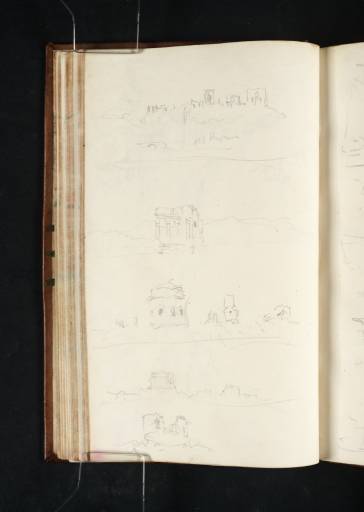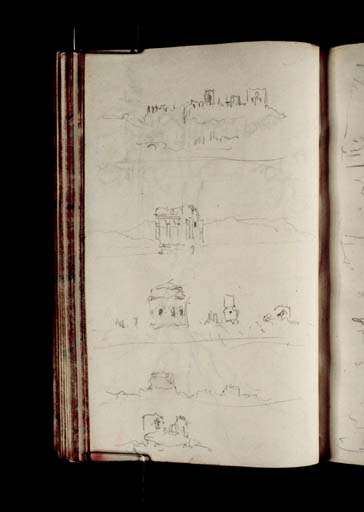Joseph Mallord William Turner Five Sketches of Ruins near the Via Appia, Rome 1819
Image 1 of 2
Joseph Mallord William Turner,
Five Sketches of Ruins near the Via Appia, Rome
1819
Joseph Mallord William Turner 1775–1851
Folio 27 Verso:
Five Sketches of Ruins near the Via Appia, Rome 1819
D15156
Turner Bequest CLXXX 26 a
Turner Bequest CLXXX 26 a
Pencil on white wove paper, 161 x 101 mm
Inscribed by the artist in pencil ‘old Rome’ underneath top sketch
Accepted by the nation as part of the Turner Bequest 1856
References
1909
A.J. Finberg, A Complete Inventory of the Drawings of the Turner Bequest, London 1909, vol.I, p.532, as ‘Five sketches; one of “Old Rome” ’.
In addition to using the Vatican Fragments sketchbook to record details of art and architecture in Rome, Turner also appears to have employed it on several occasions during his journey to or from Naples. This page contains five sketches depicting various ruined sites on, or near, the Via Appia, the road which leads south out of Rome. These are numbered from top to bottom:
a.
Thomas Ashby identified the subject of the sketch at the top as the Villa of the Quintilii and tombs on the Via Appia.1 The name of the villa is derived from its position on the fifth mile of the Via Appia, and it was popularly known as ‘Roma Vecchia’ [‘old Rome’], hence Turner’s inscription underneath the drawing.2
b.
The second sketch from the top represents a tomb on the Via Appia Nuova, formerly known as the Tempio della Salute. As recorded in an engraving by Piranesi,3 the exterior edifice of the tomb was decorated with Corinthian columns and relief panels decorated with rosettes and scrolls.4
c.
The third sketch from top appears to depict a round funerary monument which could be either the round Tomb ‘detto Berretta da Prete’,5 or the Tomb of the consul Quintus Verannius.6 Alternatively, it may also represent the same monument featured in an engraving by Piranesi, Veduta del Sepolcro di Pisone Liciniano [...]Sepolcro della famiglia Cornelia from the Veduta di Roma.7
d.
The second sketch from the bottom features another round structure, possibly the Tomb of Cecilia Metella, see the Albano, Nemi, Rome sketchbook (Tate D15384, Turner Bequest CLXXXII 47).
e.
The subject at the bottom is currently unidentified, although it appears to feature a ruined building.
Thomas Ashby identified the subject of the sketch at the top as the Villa of the Quintilii and tombs on the Via Appia.1 The name of the villa is derived from its position on the fifth mile of the Via Appia, and it was popularly known as ‘Roma Vecchia’ [‘old Rome’], hence Turner’s inscription underneath the drawing.2
b.
The second sketch from the top represents a tomb on the Via Appia Nuova, formerly known as the Tempio della Salute. As recorded in an engraving by Piranesi,3 the exterior edifice of the tomb was decorated with Corinthian columns and relief panels decorated with rosettes and scrolls.4
c.
The third sketch from top appears to depict a round funerary monument which could be either the round Tomb ‘detto Berretta da Prete’,5 or the Tomb of the consul Quintus Verannius.6 Alternatively, it may also represent the same monument featured in an engraving by Piranesi, Veduta del Sepolcro di Pisone Liciniano [...]Sepolcro della famiglia Cornelia from the Veduta di Roma.7
d.
The second sketch from the bottom features another round structure, possibly the Tomb of Cecilia Metella, see the Albano, Nemi, Rome sketchbook (Tate D15384, Turner Bequest CLXXXII 47).
e.
The subject at the bottom is currently unidentified, although it appears to feature a ruined building.
The rough character of the sketches, and the way in which the artist has crammed them onto a single page, suggests that they must have been drawn at speed, probably from a moving carriage.
Nicola Moorby
November 2009
Thomas Ashby, unpublished notes, Turner Bequest Archive, Tate. See photographs in Oreste Ferrari, Tea Marintelli, Valerie Scott et al., Thomas Ashby: Un Archeologo Fotografa la Campagna Romana Tra ’800 e’900, Rome 1986, pp.153–5, no.115 figs. 1–11.
How to cite
Nicola Moorby, ‘Five Sketches of Ruins near the Via Appia, Rome 1819 by Joseph Mallord William Turner’, catalogue entry, November 2009, in David Blayney Brown (ed.), J.M.W. Turner: Sketchbooks, Drawings and Watercolours, Tate Research Publication, December 2012, https://www


